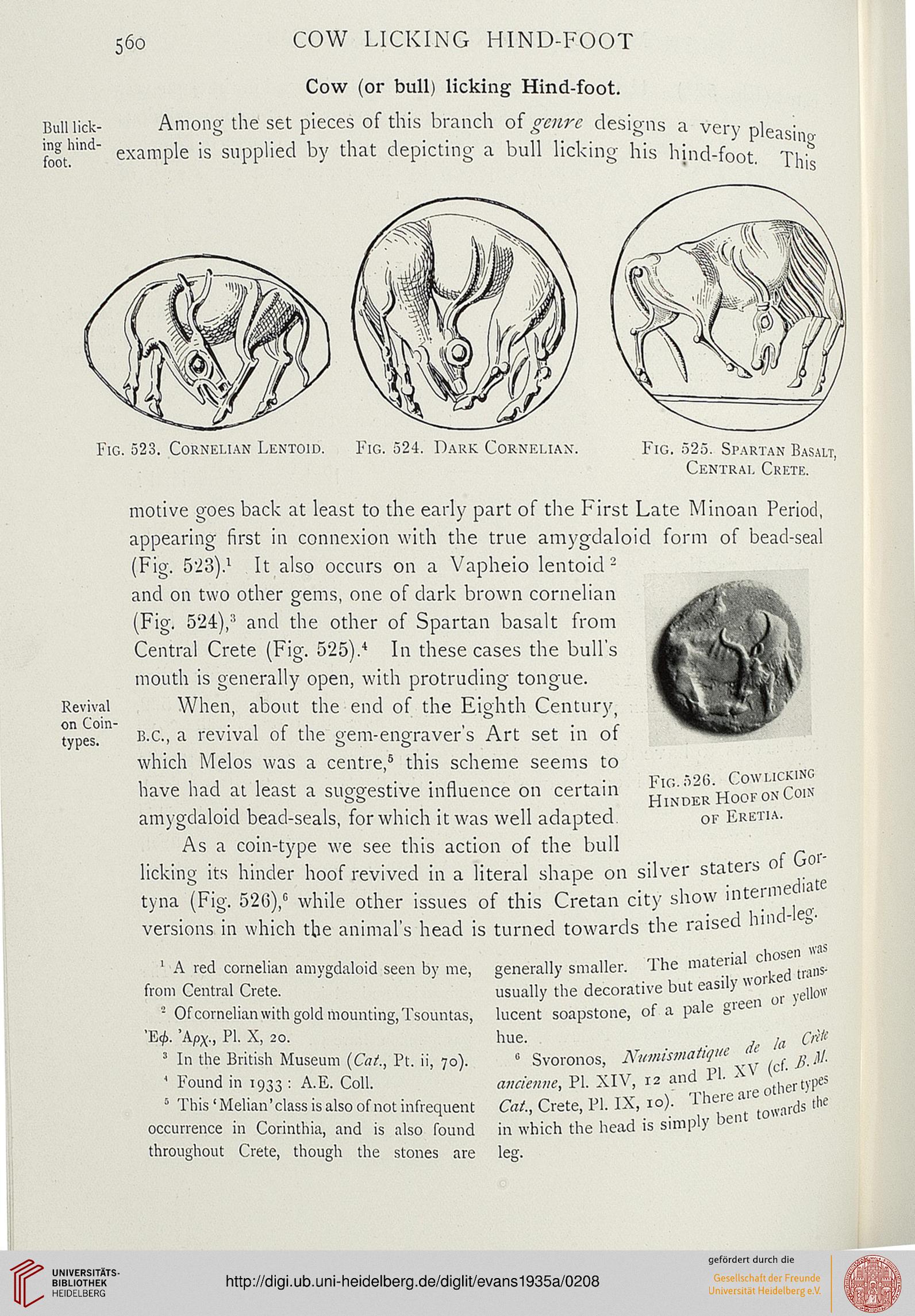56°
COW LICKING HIND-FOOT
Cow (or bull) licking Hind-foot.
Bull lick-
ing hind-
foot.
Among the set pieces of this branch of genre designs a ver., i .
xample is supplied by that depicting a bull licking his hind-foot. Th
Tig. 523. Cornelian Lentoid. Fig. 524. Dark Cornelian.
Fig. 525. Spartan Basalt,
Central Crete.
Revival
on Coin-
types.
motive goes back at least to the early part of the First Late Minoan Period,
appearing first in connexion with the true amygdaloid form of bead-seal
(Fig. 523).1 It also occurs on a Vapheio lentoid2
and on two other gems, one of dark brown cornelian
(Fig. 524),;l and the other of Spartan basalt from
Central Crete (Fig. 525).* In these cases the bull's
mouth is generally open, with protruding tongue.
When, about the end of the Eighth Century,
B.C., a revival of the gem-engraver's Art set in of
which Melos was a centre,6 this scheme seems to
have had at least a suggestive influence on certain
amygdaloid bead-seals, for which it was well adapted
As a coin-type we see this action of the bull
Fig. 526. Cowlickisc
Hinder Hoof on Cow
of Eretia.
:S Of GOI-
ediate
licking its hinder hoof revived in a literal shape on silver statei
tyna (Fig. 526),' while other issues of this Cretan city show in term
versions in which the animal's head is turned towards the raised n
■he material chosen'
1 A red cornelian amygdaloid seen by me,
from Central Crete.
- Of cornelian with gold mounting, Tsountas,
'E<£. 'Apx-, PI. X, 20.
3 In the British Museum {Cat., Pt. ii, 70).
* Found in 1933 : A.E. Coll.
5 This 'Melian'class is also of not infrequent
occurrence in Corinthia, and is also found
throughout Crete, though the stones are
enerally smaller, aw- ««~—
,e but easily worked »
of a pale areen 01 )
usually the decorativ
lucent soapstotT
hue.
■elto*
lie la
anciemie, PI. XIV, r2 and PL XV (<jert),pes
Cat, Crete, PL IX, 10). There ««■ ^ t|,c
in which the head is simply ben
leg.
COW LICKING HIND-FOOT
Cow (or bull) licking Hind-foot.
Bull lick-
ing hind-
foot.
Among the set pieces of this branch of genre designs a ver., i .
xample is supplied by that depicting a bull licking his hind-foot. Th
Tig. 523. Cornelian Lentoid. Fig. 524. Dark Cornelian.
Fig. 525. Spartan Basalt,
Central Crete.
Revival
on Coin-
types.
motive goes back at least to the early part of the First Late Minoan Period,
appearing first in connexion with the true amygdaloid form of bead-seal
(Fig. 523).1 It also occurs on a Vapheio lentoid2
and on two other gems, one of dark brown cornelian
(Fig. 524),;l and the other of Spartan basalt from
Central Crete (Fig. 525).* In these cases the bull's
mouth is generally open, with protruding tongue.
When, about the end of the Eighth Century,
B.C., a revival of the gem-engraver's Art set in of
which Melos was a centre,6 this scheme seems to
have had at least a suggestive influence on certain
amygdaloid bead-seals, for which it was well adapted
As a coin-type we see this action of the bull
Fig. 526. Cowlickisc
Hinder Hoof on Cow
of Eretia.
:S Of GOI-
ediate
licking its hinder hoof revived in a literal shape on silver statei
tyna (Fig. 526),' while other issues of this Cretan city show in term
versions in which the animal's head is turned towards the raised n
■he material chosen'
1 A red cornelian amygdaloid seen by me,
from Central Crete.
- Of cornelian with gold mounting, Tsountas,
'E<£. 'Apx-, PI. X, 20.
3 In the British Museum {Cat., Pt. ii, 70).
* Found in 1933 : A.E. Coll.
5 This 'Melian'class is also of not infrequent
occurrence in Corinthia, and is also found
throughout Crete, though the stones are
enerally smaller, aw- ««~—
,e but easily worked »
of a pale areen 01 )
usually the decorativ
lucent soapstotT
hue.
■elto*
lie la
anciemie, PI. XIV, r2 and PL XV (<jert),pes
Cat, Crete, PL IX, 10). There ««■ ^ t|,c
in which the head is simply ben
leg.





